Alchemy is a crafting profession which allows one to create mixtures such as potions and poisons, Like Enchanting, in Elder Scrolls Online, alchemy is unique from the other crafting professions in that it involves discovering the traits of the ingredients used in order to successfully craft an item.
There are a lot of traits; each Alchemy ingredient has four of them. Scroll down to see our definitive list of all alchemy ingredients and the traits of each one.
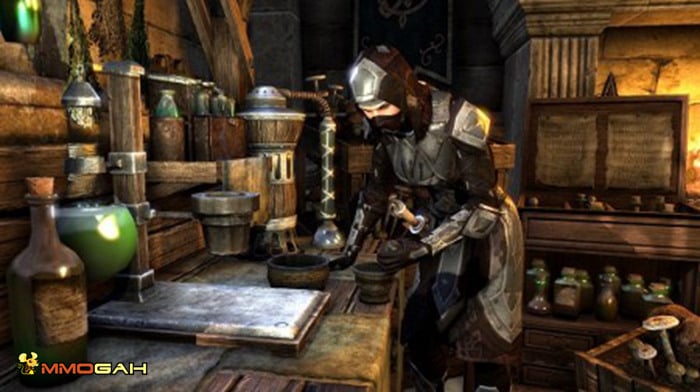
Leveling Alchemy
Just like all other skills in The Elder Scrolls Online, you have to use it to get better at it.
The ingredients for Alchemy come from plants that you can harvest while you are adventuring, and you also need water to go with them. You'll find water in barrels, glasses, mugs, cabinets, etc., so be sure to search everywhere when you're out questing and in dungeons!
For most professions you would just go and start combining ingredients to see what happens, but you don't want to do that in Alchemy. You see, some ingredients do not work with one another, so it's important that you combine the right ingredients (see the table at the bottom of this page to see what each ingredient does).
•When you're looking at the table below, keep in mind that for an attempt at a potion to be successful you must combine ingredients that share at least one common trait. EG: Blue Entoloma and Bugloss both share Restore Health.
ºIf more than one trait is shared between ingredients, then the potion will contain each shared trait.
•Another thing to be aware of: traits can also counteract one another. In our example of Blue Entoloma and Bugloss, one has Ravage Magicka and one has Restore Magicka, so these traits will be nullified.
So, once you have consulted the table below, find an Alchemy Station in town (there are also some found in special hidden areas in the world), and use it.
After you use the station, you'll be given a screen to place the ingredients in. Combine the appropriate ingredients, based on traits, and you're good to go.
Alchemy Skills and Maxing Out
To max out your alchemy level, you'll need to put skill points into Solvent Proficiency in order to get to the highest level. The only other skill that will really help you level up your alchemy is Keen Eye: Reagents, which will make it easier for you to spot plants as you're questing out in the world.
Profitability
Speaking of profit, the profitability of Alchemy should be quite high, as potions are always in demand for both PVE and PVP!
Alchemy Ingredients and Traits
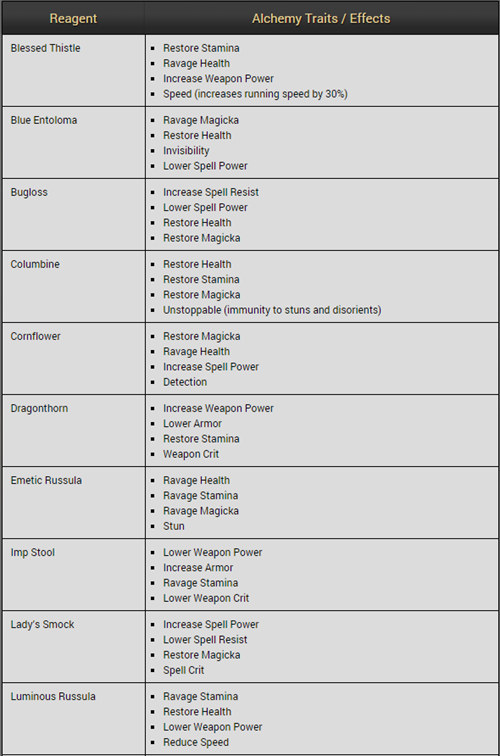
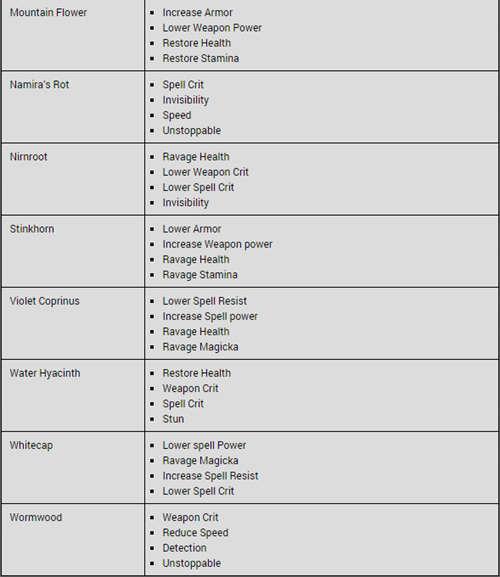
Anti Traits
This is where Alchemy gets interesting. Certain Reagent Traits have a counter version of them. Ravage Health, for example, counters Restore Health. These are called anti traits, and at least for now, they have no use in Alchemy and are nothing but a pain in the backside, because they are only applied to you. If Zenimax decides to add poisons in ESO, it may completely change the way Alchemy works.
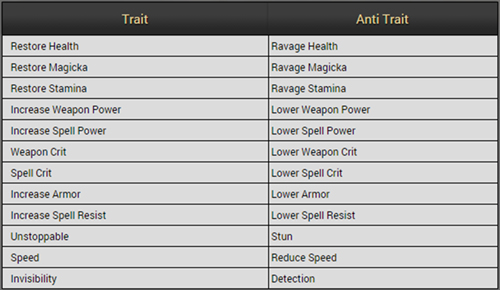
Alchemy Skill Line
The Alchemy skill line has a number of more or less useful passive skills, which give bonuses to alchemists.
Solvent Proficiency enables alchemists to use different solvent types to make higher level potions, which means it is a passive skill that needs skill point investment if you want to make useful potions at level 50.
Keen eye: Reagents will make reagents easier to spot. It looks like more of a luxury passive skill to have rather than a necessity, but if it helps you in gathering more reagents, it’s probably worth it.
Medicinal Use increases the length of potion effects, which is always good. It isn’t strictly Alchemy related though, because it doesn’t affect the actual stats of the potion its self, but how your character benefits from the potion.
Chemistry is no doubt a must have for any alchemist who wishes to produce potions for frequent use. Up to extra three potions per crafting attempt is a huge bonus from a crafter’s point of view, and is very hard to justify not taking.
Laboratory Use allows the alchemist to use more reagents per potion when crafting them. It’s unclear how this will affect the potion or its quality, but it’s fair to assume there will be a benefit. If you can use three reagents with the same effect, for example restore stamina, it’s bound to be more effective than using just two reagents.
Snake-blood reduces the negative effects in potions. It’s hard to say how useful this passive will be. If standard potions have severe drawbacks to them, Snake-blood might be a very valuable skill for all alchemists.
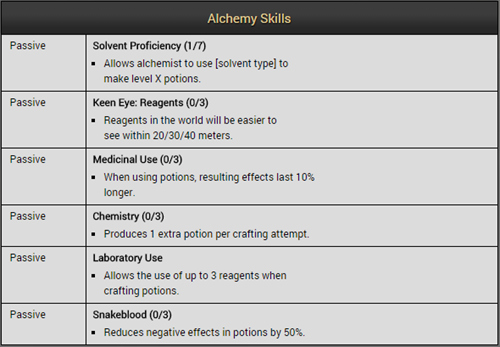
Related: weapon skill lines.
Leveling Tips
•Focus on unlocking the four traits on all twenty-six reagents first. You will earn an extra amount of inspiration every time you learn a new reagent property.
•Invest skill points in Solvent Proficiency first, allowing you to use higher grade solvents and oils which increases the inspiration gain per craft.
•Only use two reagents per solvent for leveling Alchemy. There is no difference in inspiration so you might as well save your materials.
•Some reagents are easier to farm than others. For example Water Hyacinth and Nirnroot are both easily obtained by following a body of water like a lake or river, this strategy has the added advantage of yielding solvents from pure water nodes.
•If you have extra skill points, investing at least one point into Keen Eye will make it much easier to spot ingredients while roaming the wilderness.
•It may be best to save certain reagents and not use them for leveling purposes. For example, Namira’s Rot is relatively rare, but is an important ingredient in valuable Spell Power potions. Take a look at the “recommended recipes” section below and think about whether you would rather stockpile some ingredients for later use.
•Some tiers of water are relatively more difficult to farm due to lack of bodies of water in certain zones. If you find yourself running short on solvents it isn’t terrible to use a lower tier of solvent for leveling.
•If you are going out on a alchemy harvesting run, you can turn off grass in your Video Settings which will make it much easier to spot reagents and pure water in the world.

Efficient Alchemy Level Guide
Last but not least, here is an efficient guide to get you from level 1 alchemy all the way to 50 alchemy using the least amount of plants. It will also get you all the traits researched on all of the plants.
Here is the mats required:
20x clear water
41x pristine water
48x cleansed water
60x filtered water
65x purified water
20x cloud mist
109x plant1
109x plant 2
95x plant 3
95x plant 4
3x Blessed Thistle
4x Blue Entoloma
2x Bugloss
4x Columbine
3x Cornflower
4x Dragonthorn
3x Emetic Russula
3x Impstool
3x Lady's Smock
3x Luminous Russula
2x Mountain Flower
4x Namira's Rot
5x Nirnroot
2x Stinkhorn
2x Violet Corpinus
5x Water Hyancinth
3x Whitecap
4x Wormwood
From Alchemy levels 1-30, use plant 1 with plant 2. You can use any two plants as long as they make an actual potion and you have a 109 of them. Always make sure to use the highest level water that you can, stopping at level 10, 20, and 30 to put in skill points into alchemy proficiency.
31-35, use all of the specific plants in the order below. The reason for this is the extra experience you get for trait discovery. After you follow this list, all of your plant traits should be discovered.
Blessed Thistle + Dragonthorn
Blessed Thistle + Nirnroot
Blessed Thistle + Namira's Rot
Namira's rot + Blue Entoloma
Namira's Rot + Columbine
Namira's Rot + Water Hyancinth
Water Hyancinth + Dragonthorn
Water Hyancinth + Emetic Russula
Water Hyancinth + Luminous Russula
Water Hyancinth + Lady's Smock
Lady's Smock + Cornflower
Lady's Smock + Violet Corpinus
Violet Corpinus + Emetic Russula
Emetic Russula + Stinkhorn
Stinkhorn + Dragonthorn
Dragonthorn + Wormwood
Wornwood + Luminous Russula
Wornwood + Cornflower
Wornwood + Columbine
Columbine + Mountainflower
Columbine + Bugloss
Bugloss + Whitecap
Bugloss + Blue Entoloma
Blue Entoloma + Whitecap
Blue Entoloma + Nirnroot
Nirnroot + Whitecap
Nirnroot + Cornflower
Nirnroot + Impstool
Impstool + Mountain Flower
Impstool + Luminous Russula
From this point on up until 48, you can use any plants you want as long as it makes a potion. I recommend using 95 of plant 3 and plant 4 just for speed's sake, and to make sure you do not use useful plants.
48-50, you have access to end game potions. Thus you should put a skill point in laboratory use and make good end game potions to level. It will take you 20 cloud mist to get to 50.
Hope you’ve found our Alchemy guide useful. Just like other MMO’s, if you don’t have enough time to improve your level, you can use ESO Gold to purchase not only gear and weapons, but also awesome items in game. Of course, you can buy ESO Gold right here in Mmogah, since it’s a so reliable ESO Gold seller that more and more players chose to buy ESO Gold from. Whenever you need to buy ESO Gold, our Live Chat is 24/7 online.



